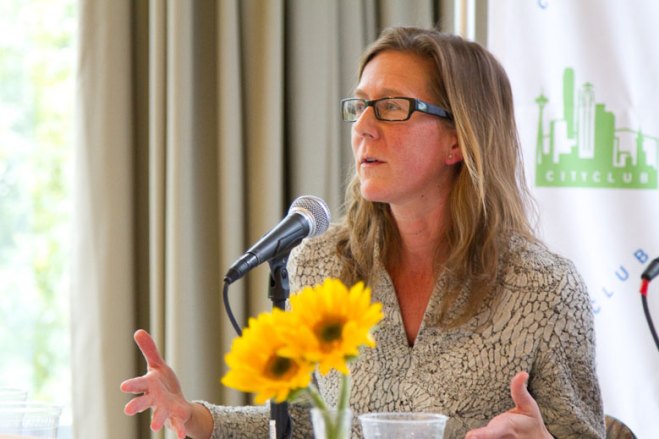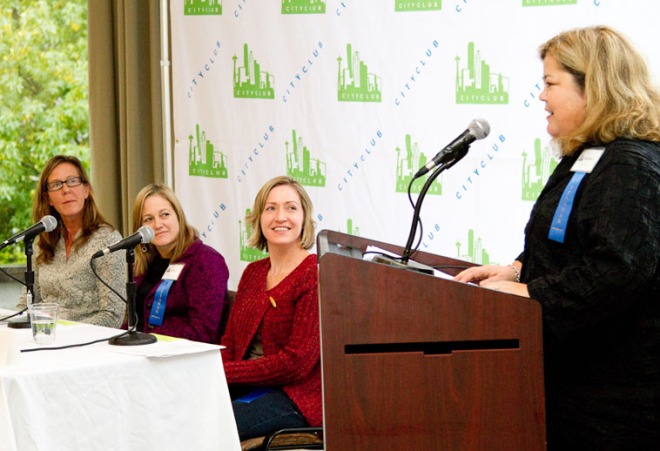Sorensen asks for questions from the general public, and the first is from a CityClub charter member, Maryel Duzan. She asks about “the white coat problem” — described generally as biases and problems introduced by personal interaction with a doctor or scientist. Examples of the problem cited by Duzan are that some people don’t remember what they’ve been told, or feel personally compelled toward consent by this interaction.

Duzan’s question, then is: As a potential solution to the white coat problem, has anyone considered using videos to establish understanding and consent in place of a one on one interaction?
Sewards notes that “We think of consent as an on-going process.” That is, they ensure participants have an on-going understanding and that forms stay updated.
Russell, for GAPPS describes that their study coordinators know the women across a long period of time, so there are a lot of questions back and forth.

For GAPPS donors then, there is a lot of time to think about consent.
Edwards adds there are new consent forms with more options, with which you can opt into or out of different parts of the research.

Still better, some of Edwards’ bioinformatics colleagues are working on a software interface with a question and answer experience on a computer. This is to lead you through the choices and help identify what you really want in terms of consent.
Next, writer Sally James from the Northwest Science Writers Association (@jamesian on Twitter) begins: “I find the definition of ‘informed’ to be really tricky right now. For those of us familiar with proteomics (the large-scale study of proteins, particularly their structures and functions) we can imagine: can anyone right now know the ramification of giving a DNA sample?

We are on the cusp of learning so much more information, and things are changing so quickly, James summarizes: “Can anyone know what we’re consenting to?”
Edwards replies: “This is exactly why I wonder whether we’ve out grown the usefulness of classic consent. I think we’ve outrun the term ‘informed consent’. We don’t know all the risks and benefits with respect to genetic information. We’ve had a number of conferences with experts in the room … and we still cannot anticipate all the risks.”

Edwards continues: “We should shift to consenting to a process … [such as] I agree to be a part of this bank, I understand there is a governing process, and if things change you will contact me again,” rather than committing to everything in the future at this one time.
Renee Delong, Regulatory Affairs Project Coordinator at Fred Hutchinson Cancer Research Center asked “What steps do you recommend to build public trust around biorepositories?”

Delong added, “I believe in the promise of biorepositories,” while mentioning a recent New York Times article about use of the Internet as a sort of repository for patients with rare genetic disorders. These patients openly share symptoms and diaries online which researchers can then, also access.
Edwards replied that communication and being transparent, having accountability, and having systems in place to know where the data are are all essential to building trust. She also stressed that biobank experts don’t yet know all the answers and they are open to suggestions.
Edwards agreed that people are absolutely owed some results back, but noted that not everyone wants to known their own personal results. Many people just want to know how the research is going in general. Individual results may not be conclusive or relevant, but scientists can give back more in terms of general results.
To another question from Delong, Russell replies that GAPPS participant-donors can change their minds up until that specimen has been sent out for research. Samples left behind or not yet used can be destroyed, and donors can be given confirmation that it’s been done.
Sewards adds: Every consent form has the phone number of the reviewing IRB, and they would love to hear from more people! — http://www.washington.edu/research/hsd/
Wendy, a member of CityClub and not a scientist says: “I would donate blood for science. What is the parade of horribles?” i.e. what are people’s objections to doing the same? She continues, “I don’t understand what all the issues are. If data are anonymous what are people worried about?”
Sewards outlines: “We are concerned if someone’s genetic information is out there without enough safeguards. Say an employer or someone else may find data related to health test results, like a test for HIV, and that data could come back to hurt you.”

Sewards particularly notes again that right now, DNA is seen as only identifiable with related and associated information, but what about five years from now?
Edwards adds: If you are a part of a clearly identifiable community such as by your ethnicity, there is also concern about research which could stigmatize your community. An example: whether a particular ethnicity is more inclined to commit crime. Perhaps you gave your blood to fight disease and it ends up being used in unintended ways, which are not personally, but socially disagreeable to you.
Ryan Luce, co-founder of Corengi asked whether there is a public health consideration which answers the privacy concerns of individuals.

Edwards replied that some patient groups, especially want more data shared and publicly. Open data and more open access to data and research might bypass even institutions themselves. Some want the data available to anyone who might use it and make a breakthrough.
Russell noted that many of the women in GAPPS have no problem with data sharing but that GAPPS still feels the responsibility of that trust being placed in them. “We don’t want people to ever feel bad about what they did.”
Sorensen, our moderator offers one closing question: “We have an enormous opportunity to move research forward and transform medicine but must ensure the public trust. If engaging the public is the way to do it, how can the people here today get more involved?”
Edwards answers: Continue conversations like this one, join book groups, bring all of this up during dinner with friends.
Raise these issues and get people thinking about them. This is not straightforward, so we need more people thinking about it and we need more and different ideas. Jen Wroblewski and NWABR can help put book groups or other conversations together and Edwards and her colleagues at UW would love to have more public conversations — so get in touch, http://www.nwabr.org/about/contact.html and http://depts.washington.edu/bhdept/facres/kfe_bio.html.
Russell points to The Immortal Life of Henrietta Lacks by Rebecca Skloot, which tackles some of the ethical issues involved. NWABR has prepared a discussion guide which can be used personally or by anyone wanting to facilitate discussions — download it in PDF format, here.
Russell also mentions a recent article in Newsweek, “The Prematurity Puzzle – Research on early births could hold clues to disorders like autism and cerebral palsy.” Her advice is to read and engage in all of this.
Sewards concludes: contact your local representatives if you have any concerns. The rights of research subjects are codified by the federal government and we want to make sure you are aware of your rights!

Read on below for the moderated panel discussion before public questions and answers, and see a guide to all posts on this blog, here. — Brian Glanz for NWABR











